|
A Garden Path Can
|
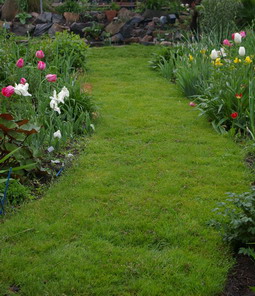
Plants or Paving?
There are definitely two aspects to creating a wonderful garden path. Where does it go? What is it made of? The question of where it goes, opens the whole art form we call garden design. There is not room here to discuss this in any depth. It is sufficient to look at the basic need for a path in the garden. A good path leads us from one place to another. This happens when the gardener has created a variety of areas that you want to move through. Each of these areas would ideally feel different when the path leads you into them. The use of different colours, textures and growing conditions, (sun vs shade,) can help create the illusion of moving through a large and varied space even in a relatively tiny back yard.
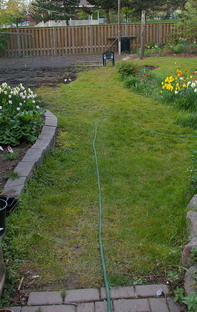 Is Grass A Path?
Is Grass A Path?
Well yes it certainly can be.(As in the picture above.) It starts when you make the transition and see the whole property as a series of connected gardens rather than a large expanse of grass with some flower beds along the edges. Any material, including grass, can become a pathway between the planted areas, leading us through the various sections of that garden. Even as I tear up more and more of the grass, (pictures left & right below) to create winding paths between each garden area, one of those garden areas, that the paths lead to, is an expanse of grass. That isolated section of turf becomes a garden of its own with its own purpose. The croquet court is there, my daughter’s dogs use the space when they visit. It has a purpose. It’s not just there in the absence of anything else.
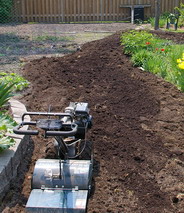
The gardens in the front yard are separated, defined and explored by the narrow grass paths between them. Again the grass sections are intentional and not just a vast expanse of green that needs a lot of attention to look good.
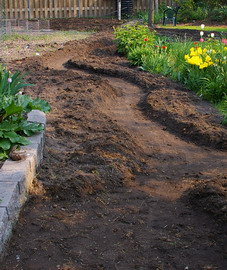 What Else Can Make A Path?
What Else Can Make A Path?
Here the choices are infinite. Stone, gravel, bricks, wood chips, ground cover plants, even asphalt could make your garden path. Each of those choices helps to create the mood and the experience that you and your visitor get as they wander along them.
How Do I Build Them?
A path wants to be firm and supportive of its traffic. In most cases this requires the removal of a few inches of the topsoil (picture left) and replacing it with a solid gravel base. Something that will pack down firmly such as the limestone products, ‘dust and chips,’ or ‘fine crusher run,’ will do the job adequately. They can even be the finished path if you like the look and feel. I’m presently adding a layer of crushed granite to the top of mine to give a different colour and texture.(Finished picture right.)
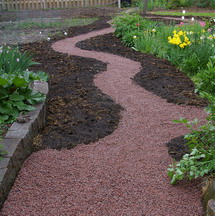
Even a garden path of wood chips or small bark nuggets will work much better if laid over a base of packed gravel.
The gravel stops the finish materials from sinking into the soil and disappearing. This costs money and creates a muddy path. My new path will lose some of it’s sterility by the random placing of similarly coloured flat stones and strategically planted ground covers such as Wooly Thyme or Bearberry. There are several similar ground cover plants that will withstand a fair amount of pedestrian traffic.
Added Benefits
Of course it’s just coincidence that replacing 6' /2 m of grass between these two beds in favour of a 2' / 60 cm winding gravel path happens to leave me with more space to plant other things.
I’m looking at small trees to put at the curves in the path to enhance the feeling of entering a new space.
You can search my entire site for answers to your other gardening mysteries.
